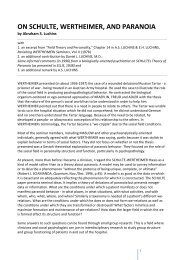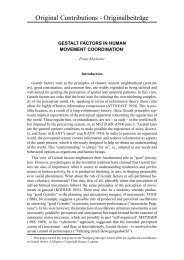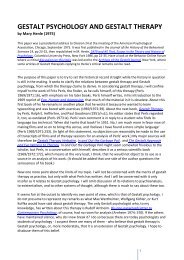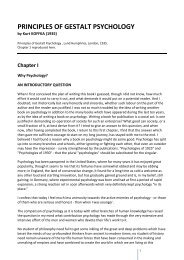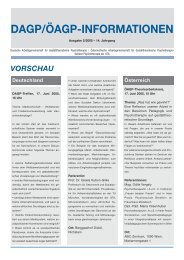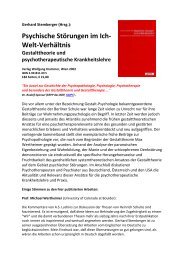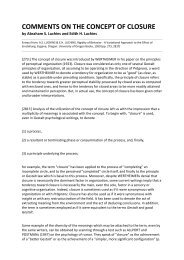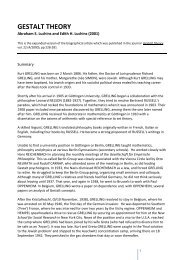pdf-Download - Society for Gestalt Theory and its Applications (GTA)
pdf-Download - Society for Gestalt Theory and its Applications (GTA)
pdf-Download - Society for Gestalt Theory and its Applications (GTA)
Create successful ePaper yourself
Turn your PDF publications into a flip-book with our unique Google optimized e-Paper software.
On the basis of these ideas, I developed my first technique <strong>for</strong> inducing lucid dreams in 1959. Icalled it the "Reflection Technique." Using this technique, the subject asks him or herself severaltimes during the course of the day: "Am I awake, or am I dreaming?" The purpose is to achieve agenerally critical attitude towards one's state of consciousness. When confronted with unusualexperiences, this facilitates recognition of the dreaming state.After four weeks I had my first lucid dream. I recognized that I was dreaming because I saw anaunt whom I knew to have been dead <strong>for</strong> some time. Since I was not at all acquainted with suchphenomena at that time, I was at first fascinated by this new experience. Later, however, I wasseized by a kind of claustrophobic feeling because I did not know how or whether I would be ableto get out of this dream world. I finally woke up after staring at a flower in the dream environmentuntil the flower <strong>and</strong> the entire surroundings became blurred.PRICE <strong>and</strong> COHEN (1988), who refer to only one of my articles translated into English, havereferred to the reflection technique as the development of an active attitude. With respect to theearly application of the technique this is correct. A process of active questioning, however,ultimately gives rise to a passively receptive focus on current experience which, in turn, makes theposing of critical questions a superfluous matter. In other words, increased practice helps developthe disposition making it possible to recognize the dreaming state when triggered by unusualevents.A first important goal in improving the effectiveness of the reflection technique was finding theappropriate criteria <strong>for</strong> recognizing the dreaming state. These criteria make it possible tospontaneously recognize that one is dreaming: particularities of dreamlike perception <strong>and</strong>/or thecontradiction between knowledge of events in a waking state <strong>and</strong> momentarily experienceddream events. It is also possible to test whether one is awake or dreaming through a series ofphysical <strong>and</strong> mental activities. For example, the subject turns himself approximately 180 degrees<strong>and</strong> then attempts to st<strong>and</strong> still. In a dream state, as a rule, the body continues to turn in the samedirection or the surroundings begin to revolve in the opposite direction. However, the subject mayhesitate to conduct such a test in the presence of other people because of the possibility thathe/she is awake. After all most of us shy away from carrying out such unusual activities in front ofpotential onlookers. Thus mental tests may be preferable.One of the most effective tests is trying to remember what has happened during the immediatelypreceding period of time. Should one experience bizarre events or a lapse of memory, this mayindicate that one is dreaming. However, this test is useless if the subject wakes up, since it couldbe a "false awakening." There<strong>for</strong>e, turning a light on, <strong>for</strong> example, is recommended upon wakingup. If the light does not go on, this may signify a dream state.We have found countless examples that suggest the apparent existence of various <strong>for</strong>ms ofpsychological resistance which appear to hinder or prematurely end dream lucidity (THOLEY, 1981;1988b).For instance during one of my own dreams I saw houses, trees <strong>and</strong> other objects all st<strong>and</strong>ingupside down. I immediately thought that I was dreaming. Shortly thereafter it seemed as if I had apair of glasses on. It occurred to me that the glasses might have been equipped with reversinglenses such as those used in psychological experiments dealing with perception. When Iproceeded to take off the glasses I saw my surroundings in a normal, upright position <strong>and</strong> I no3



